Lung Parenchyma - Knobology and Imaging Technique
Knobology and Imaging Technique
2. Knobology Optimization
3. Image Acquisition
Parenchyma PoCUS has its specific Image Acquisition finesses that are crucial to producing high quality images:
1. Probe Selection
2. Knobology Optimization
3. Image Acquisition
1. Probe Selection:
Curvilinear: Its large FOV allows one to view several adjacent ICS simultaneously - evaluating more parenchyma per view. Pleural line is relatively well imaged.
Phased-Array: Small footprint allows one to wedge into an ICS, but limited to evaluating a small region per view. Another problem is that the pleural line poorly imaged with this probe.
Linear: High frequency allows one to image the pleura in detail, but small FOV is small.
Personally, I prefer the curvilinear probe if it is available, so I can view more of the lung at once with least amount of effort. The linear probe is deployed if pleura evaluation will help with the diagnosis.
Curvilinear: Its large FOV allows one to view several adjacent ICS simultaneously - evaluating more parenchyma per view. Pleural line is relatively well imaged.
Phased-Array: Small footprint allows one to wedge into an ICS, but limited to evaluating a small region per view. Another problem is that the pleural line poorly imaged with this probe.
Linear: High frequency allows one to image the pleura in detail, but small FOV is small.
Personally, I prefer the curvilinear probe if it is available, so I can view more of the lung at once with least amount of effort. The linear probe is deployed if pleura evaluation will help with the diagnosis.
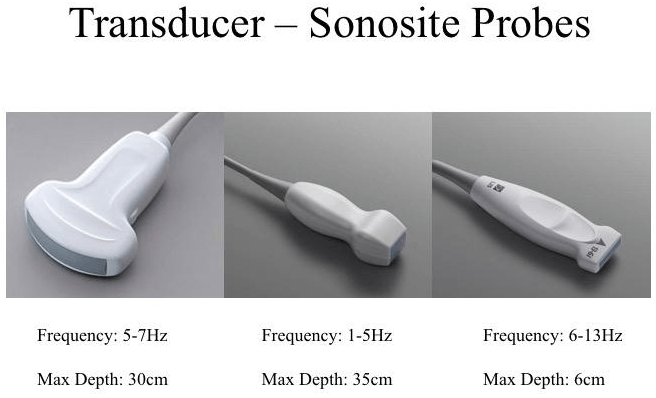
2. Knobology - Optimal Settings:
The utility of parenchyma PoCUS is dependent on generation of US artifacts. Any processor settings that attenuate artifact production should be OFF for this indication.
At minimum, do turn off Tissue Harmonics and Multi-Beam (aka. Compound Imaging). Some newer machines have a preset "Lung" Mode whereby the knobology are optimized for thoracic PoCUS.
Exercise:
The utility of parenchyma PoCUS is dependent on generation of US artifacts. Any processor settings that attenuate artifact production should be OFF for this indication.
At minimum, do turn off Tissue Harmonics and Multi-Beam (aka. Compound Imaging). Some newer machines have a preset "Lung" Mode whereby the knobology are optimized for thoracic PoCUS.
Exercise:
Try imaging parenchyma with different settings and observe what happens to the artifact images
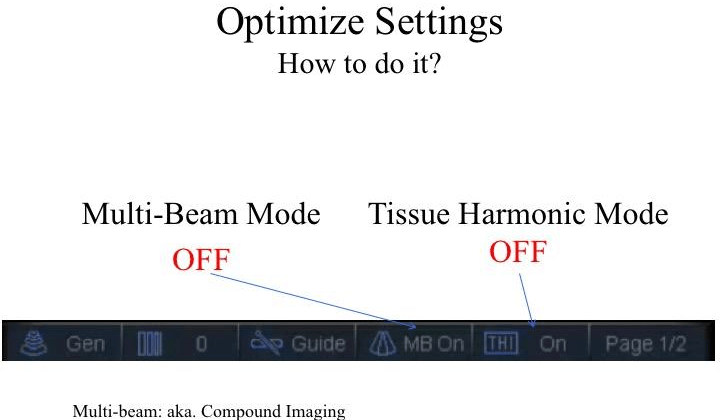
3. Image Acquisition - Where to scan?
There are several proposed methods to divide up the thorax into standardized zones. The major differences are the number and, hence, size of the zones scanned. The more you divide up the thorax, the more zones you will be scanning. The advantage is that it will be scrutinizing. However, it is more time consuming.
The thoracic partitioning method shown on the left is commonly used. Its origin stem from critical care patients who cannot sit up. Each hemithorax is divided into 4 zones demarcated by PSL (Paratsternal Line), AAL (Anterior Axiliary Line), PAL (Posterior Axiliary Line), and the 5th Intercostal Space.
There are several proposed methods to divide up the thorax into standardized zones. The major differences are the number and, hence, size of the zones scanned. The more you divide up the thorax, the more zones you will be scanning. The advantage is that it will be scrutinizing. However, it is more time consuming.
The thoracic partitioning method shown on the left is commonly used. Its origin stem from critical care patients who cannot sit up. Each hemithorax is divided into 4 zones demarcated by PSL (Paratsternal Line), AAL (Anterior Axiliary Line), PAL (Posterior Axiliary Line), and the 5th Intercostal Space.
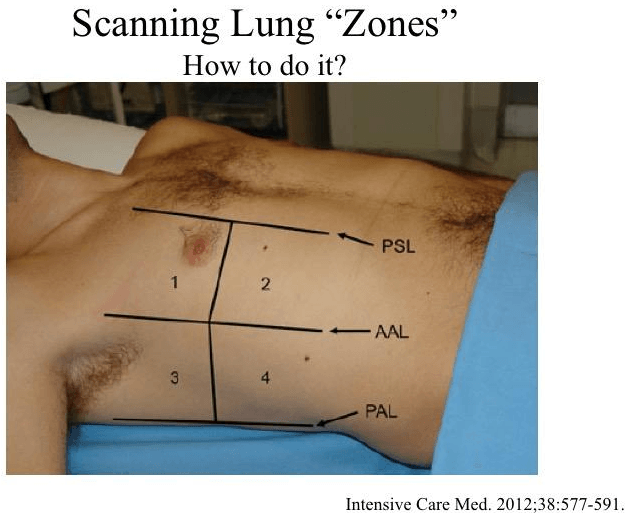
The left is a schematic diagram correlating the partition method described above to the lobes of the lung.
Anterior:
Anterior:
- RZ1 = Right upper lobe (RUL)
- RZ2 = Right middle lobe (RML)
- LZ1 = Left upper lobe (LUL)
- LZ2 = Lingula (heart is usually in the way)
- RZ3 = RUL/RML - depends on the cut
- RZ4 = Right lower lobe (RLL) + costodiaphragmatic recess (CDR)
- LZ3 = LUL/LLL - depends on the cut
- LZ4 = Left lower lobe (LLL) + CDR
Posterior:
if the 5th intercostal space is extended all the way to the back, the posterior thorax can be further partitioned into Z5 and Z6. Have the patient self-hug to displace the scapula to expose Z5.
- RZ5 = RUL
- RZ6 = RLL + CDR
- LZ5 = LUL
- LZ6 = LLL + CDR
CDR: parietal pleural reflection around the inferior aspect of the where non-located effusion can collect in an dependent position.
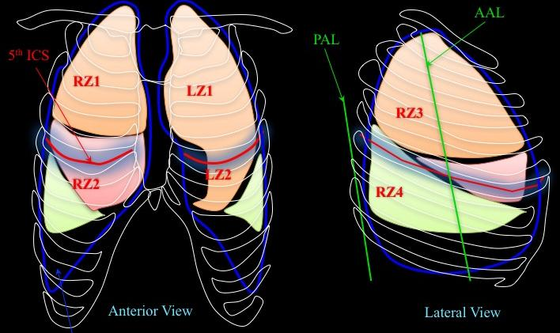
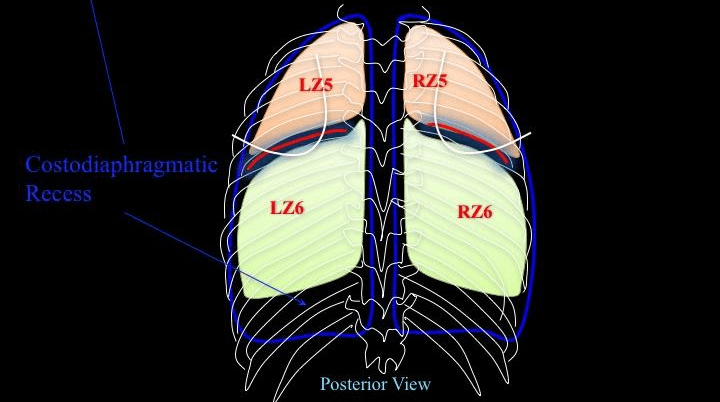
3. Image Acquisition - How to place the probe?
- Place probe perpendicular to an intercostal space
- Indicator points towards the head
- Attain this image - termed "Bat Wing" composing of the structures in the schematic diagram
- UTMOST: render the US beam perpendicular to the PLEURA (not the chest wall) to generate thoracic US artifacts
Note: the visceral and parietal pleura cannot be resolved into two separate structures by US. When they are apposed, they are seen as one line - hyperechoic pleural line.

What happens if the probe is not perpendicular to the pleura?
This image shows what happens when the US beam is not perpendicular to the VPPI:
This image shows what happens when the US beam is not perpendicular to the VPPI:
- pleural line is less echoic and coarser
- A-line artifacts are attenuated or mitigated
- by far, anecdoctally, this is the most common problem with thoracic image acquisition
- you may notice that the probe is quite tilted in relation to the chest wall when the best image is acquired. However, in fact, the US beam is perpendicular to the VPPI.

A common question:
Why placing the probe perpendicular to two adjacent ribs is preferable to placing the probe parallel the intercostal space?
When the probe is placed parallel to the ICS, the fibers of the intercostal muscles are imaged along their long-axis - these muscles run along the ICS. When the patient breaths, especially during forceful respiration, the dynamic movements of these muscles will be captured. Given their proximity to the Pleural Line, it can make Pleural Sliding assessment more difficult - which one is moving?
If the probe is placed perpendicular to the two ribs, the US beam cuts the intercostal muscles in their short-axis, therefore their movements are not captured. Hence, Pleural Sliding interpretation will not be confounded. However, the parallel placement does allow one to evaluate more pleura at once.
When the probe is placed parallel to the ICS, the fibers of the intercostal muscles are imaged along their long-axis - these muscles run along the ICS. When the patient breaths, especially during forceful respiration, the dynamic movements of these muscles will be captured. Given their proximity to the Pleural Line, it can make Pleural Sliding assessment more difficult - which one is moving?
If the probe is placed perpendicular to the two ribs, the US beam cuts the intercostal muscles in their short-axis, therefore their movements are not captured. Hence, Pleural Sliding interpretation will not be confounded. However, the parallel placement does allow one to evaluate more pleura at once.

Take Home Message:
- Render the US beam perpendicular to the VPPI - crucial for lung parenchyma US
- Try different angle of insonation to the thorax and see what happens to the image
- Try imaging the thorax perpendicular and parallel to the ICS
